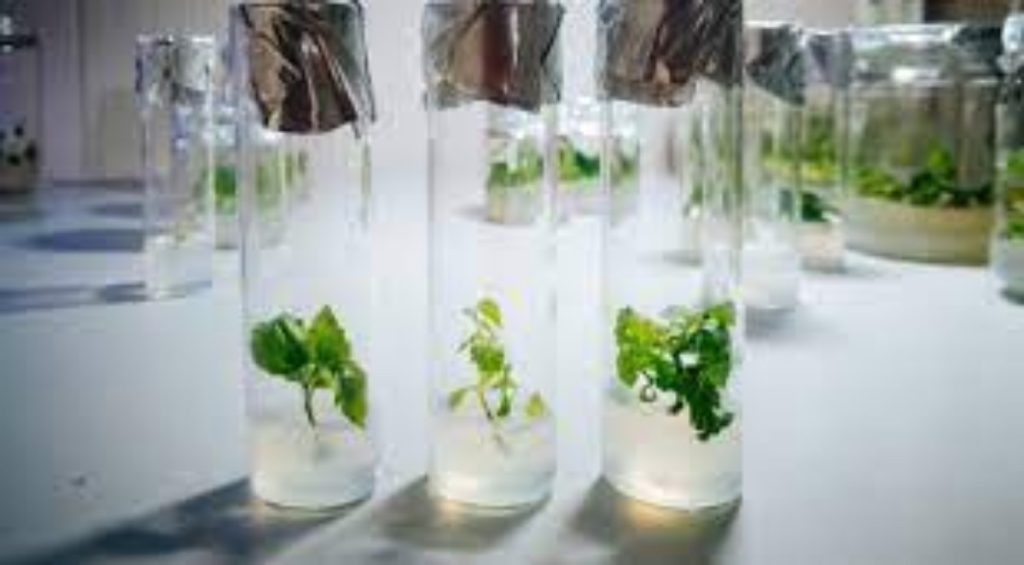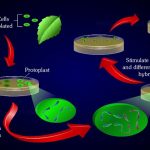Abstract
This study was performed for comparison of meristem culture technique with shoot tip culture technique for obtaining virus-free plant, comparison of micropropagation success of two different nutrient media, and determination of effectiveness of real-time PCR assay for the detection of viruses. Two different garlic species (Allium sativum and Allium tuncelianum) and two different nutrient media were used in this experiment. Results showed that Medium 2 was more successful compared to Medium 1 for both A. tuncelianum and A. sativum (Kastamonu garlic clone). In vitro plants obtained via meristem and shoot tip cultures were tested for determination of onion yellow dwarf virus (OYDV) and leek yellow stripe virus (LYSV) through real-time PCR assay. In garlic plants propagated via meristem culture, we could not detect any virus. OYDV and LYSV viruses were detected in plants obtained via shoot tip culture. OYDV virus was observed in amount of 80% and 73% of tested plants for A. tuncelianum and A. sativum, respectively. LYSV virus was found in amount of 67% of tested plants of A. tuncelianum and in amount of 87% of tested plants of A. sativum in this study.
Introduction
Total garlic production of Turkey was 105, 363 tons, and 18–20% of this production is provided from Taşköprü district of Kastamonu province. Kastamonu garlic clone (A. sativum) is suitable for winter consumption, can be stored for a long time, and is suitable for processing due to dry matter content. Allium tuncelianum, called Tunceli garlic, is only common in Tunceli province of Turkey, especially around Munzur Mountains in Ovacık district, and it is known as an endemic to this region. Unlike other garlics with multiple-cloved bulb, A. tuncelianum has single-cloved bulbs and has small formations like a small bulbs, and it can also produce fertile flowers and seeds. The most important problem of garlic production in Turkey is infected areas due to pests and diseases carried via contaminated seedling. Garlic production areas and seedling production areas are not separated in Turkey. Pests and diseases can be carried via contaminated material in garlic propagated vegetatively because of sexual sterility. The most important ones of these diseases and pests are nematode (Ditylenchus dipsaci), white rot disease (Sclerotium cepivorum), and viruses that cause a loss of between 30% and 100% of production and the most common viruses are onion yellow dwarf virus (OYDV) and leek yellow stripe virus (LYSV). Fidan et al. reported that these two viruses together affect the plant negatively and result in a yield loss of up to 78%. There is no effective chemical control method against viruses directly. For this reason, the most common method for obtaining virus-free plant is meristem culture technique. Different researchers have also reported that shoot tip remained insufficient for obtaining the virus-free plants. Biological (mechanical inoculation, indexing), serological (enzyme-linked immunosorbent assay—ELISA), and molecular (polymerase chain reaction—PCR) methods are used for detection of viruses in plants and identification of these viruses. Real-time 4 PCR assay, which is one of the PCR types, is able to provide quantitative assessment. One of the main advantages of the real-time PCR is the very low chances of infection and detection of viruses with high efficiency. Detection of viruses through real-time PCR method has been performed successfully by many researchers such as Roberts et al., Korimbocus et al., Balaji et al., Lunello et al., Yılmaz, Mehle et al., and Fidan et al..
The objectives of this study were (i) comparison of meristem culture technique with shoot tip culture technique to obtain virus-free plants, (ii) comparison of micropropagation success of two different nutrient media and two different garlic species (A. tuncelianum and A. sativum), (ii) to see the effectiveness of real-time PCR assay on detection of viruses.
Material and Methods
This study was conducted at the Department of Horticulture, University of Çukurova Turkey, and Adana Veterinary Control Institute, Turkey between the years 2009 and 2010. Allium sativum (Kastamonu garlic clone) and Allium tuncelianum garlic species determined to be infected with viruses were used as plant material. A. sativum and A. tuncelianum garlic samples were provided by Kastamonu-Taşköprü and Tunceli-Ovacık regions of Turkey, respectively.
Meristem and Shoot Tip Culture Studies
A. sativum and A. tuncelianum garlic species were propagated via meristem and shoot tip cultures. Cloves of garlic were waited in 25% sodium hypochlorite for 20 minutes for surface sterilization and washed 4-5 times with sterile water. Meristem and shoot tips from sterile cloves were extracted by sterile forceps and scalpels under a stereobinocular microscope in laminar flow and placed into glass tubes containing MS nutrient medium. All cultures were incubated in the growth chamber at 25°C, under 3000 lux light and 8 hours dark and 16 h light photoperiod conditions. Germinated meristem and shoot tips were transferred to two different nutrient media (Medium 1: MS medium containing 0.5 mg L−1 2-IP, 0.2 mg L−1 NAA, and 30 g L−1sucrose; Medium 2: MS containing 2 mg L−1 BA, 0.5 mg L−1 IBA, and 30 g L−1 sucrose) for micropropagation. After 6 weeks, number of shoots per plant were recorded, and the shoots were subcultured. The experiment was designed in a completely randomized experimental design with three replications and thirty explants included per replication.
Variance analysis was conducted to evaluate the results, and Tukey test was used for controlling the significance of the differences.
Real-Time PCR Studies
Sixty in vitro plants (15 of them from meristem culture of A. tuncelianum, 15 of them from shoot tip culture of A. tuncelianum, 15 of them from meristem culture of A. sativum, and 15 of them from shoot tip culture of A. sativum) were used for real-time PCR studies. High Pure Viral Nucleid Acid Kit was used for RNA extraction of garlic samples. 200 μL working solution and 50 μL proteinase K were added to 1.5 mL nuclease-free microcentrifuge tube containing 100 mg plant samples and pulverized. After the mixture was mixed, it was incubated for 10 min at 72°C. Then, 100 μL binding buffer was added and mixed. Mixture was transferred into the upper reservoir of combination of high pure filter tube and the collection tube and spun for 1 min at 8,000 g in a centrifuge. Collection tube was removed and filter tube was placed into a new collection tube. Then 500 μL inhibitor removal buffer was added and spun for 1 min at 8,000 g in a centrifuge. Collection tube was changed with a new one. Then 500 μL wash buffer was added and spun for 1 min at 10,000 g in a centrifuge. The collecting tube was changed, and the washing step was repeated. Filter tube was placed into new sterile 1.5 mL nuclease-free microcentrifuge tube, and 75 μL elution buffer to elute the viral nucleic acid followed by spinning for 1 min at 13,000 g in a centrifuge. Filter tubes placed in the Eppendorf tubes were removed, and purified viral nucleic acid was extracted.
Obtained pure viral nucleic acids were converted to cDNA with reverse transcription PCR (RT-PCR) and incubated at −15/−20°C in a freezer. Transcriptor High Fidelity cDNA Synthesis Kit was used for converting RNA to cDNA. This process was completed in two steps. 2 μL random primer, 1 μL PCR-grade water, and 8.4 μL RNA per sample were used to prepare PCR mixture in the first step. This mixture was incubated at 65°C for 10 min. Prepared mixture in the second step consisted of 4 μL transcriptor reverse transcriptase reaction tampon, 0.5 μL protector RNAse inhibitor, 2 μL deoxynucleotide mix, 1 μL DTT, and 1.1 μL transcriptor reverse transcriptase enzyme. These two mixtures were mixed and incubated at 45–55°C for 10–30 min and then at 85°C for 5 min. Thereafter, cDNA synthesis was completed and stored at −20°C. Real-time PCR mix-conducted in a 20 μL volume containing 1xSYBR Green master mix (Roche applied science), 5 nM forward-reverse primers, and PCR grade water, using the following program: 10 min at 95°C for activation of DNA polymerase, 45 cycles of 10 s at 95°C, 30 s at 60°C, 1 s at 72°C, 30 min at 40°C and 30 s at 40°C for cooling in Roche LightCycler 2.0 Real-time PCR. Evaluation was performed by qualitative detection program of this thermocycler. Mixture containing 5 μL isolated DNA from samples, 2 μL SYBER Green master (it consisted, fast start Taq DNA polymerase, reaction buffer, MgCl2, dNTP mix, and SYBER Green-Roche), 5 μL forward and reverse primers, 2.4 mM Mg, and PCR-grade water (total volume 20 μL) was prepared for the detection in real-time PCR using 600 s at 95°C for denaturation of DNA, 45 cycles of 10 s at 95°C, 30 s at 60°C, 2 min at 72°C, and 30 min at 40°C for cooling.
SYBER Green was used for detection of OYDV and LYSV viruses. The primers used in this study (Table 1) for OYDV and LYSV viruses were performed using primers registered in genbank as forward OYDV primer (F-OYDV), 1099–1122 positions of sequences registered as AJ292223 in GenBank Database, as reverse OYDV primer (R-OYDV) 1306–1325 positions of AJ292223, as forward LYSV primer (F-LYSV) 789–808 positions of sequences registered as AY007693, and as reverse LYSV primer (R-LYSV) 839–854 positions of AY007693.
Results
Ninety shoot tips and ninety meristems were used for A. tuncelianum in this experiment. Meristems transformed to plants in eight weeks. While 85 of meristems could grow without any problems, three of them could not germinate, and as infection problem was observed in two meristems. Cultured shoot tips were turned into plants in 3-4 weeks. Eighty-four shoot tips germinated healthy; only 1 shoot tip could not grow and 5 of ninety shoot tips were found to be infected. Plants obtained meristems of A. tuncelianum were transferred to two different nutrient media for micropropagation. Number of shoots were recorded in both first micropropagation and subculture were higher in Medium 2 compared to Medium 1, and the differences between the two media were found to be significant statistically. In the first propagation, 14.10 shoots/plant and 4.63 shoots/plant were obtained from Medium 2 and Medium 1, respectively. Similar results were provided from subculture. 13.27 shoots/plant in Medium 2 and 3.93 shoots/plant in Medium 1 were determined. Shoot tip culture results showed that Medium 2 was better compared to Medium 1. 11.37 shoots/plant and 2.41 shoots/plant were obtained from Medium 2 and Medium 1 in the first propagation, respectively. 8.93 shoots/plant and 2.36 shoots/plant were observed in Medium 2 and Medium 1 in subculture, respectively. Considered in terms of explants, meristem explants were found to be more successful compared to shoot tip explants in both garlic species and nutrient media.
The experiment for A. sativum was designated with 90 meristems and 90 shoot tips. While 89 meristems could transform into plant in meristem culture (the remaining one meristem was probably damaged), 87 shoot tips could germinate in shoot tip culture (the remaining 3 plants were infected). Meristem and shoot tip culture results of A. sativum showed that Medium 2 was more successful compared to Medium 1. Number of shoots/plant obtained from different tissue culture techniques and different garlic species are given in Table 2. As seen in Table 2, 11.67 shoots/plant and 5.41 shoots/plant were counted in Medium 2 and Medium 1 in the first micropropagation, respectively. In subculture, 11.61 shoots/plant and 5.56 shoots/plant were obtained on Medium 2 and Medium 1, respectively. These results compared with results of A. tuncelianum; number of shoots of A. tuncelianum in Medium 2 were higher than of A. sativum in both nutrient media. In Medium 1, A. sativum gave slightly higher results compared to A. tuncelianum. In shoot tip culture of A. sativum, Medium 2 and Medium 1 gave 9.84 shoots/plant and 2.93 shoots/plant for the first micropropagation, respectively. 10.17 shoots/plant from Medium 2 and 3.61 shoots/plant from Medium 1 were obtained in subculture.
Sixty garlic plants propagated via meristem and shoot tip cultures were tested in terms of OYDV and LYSV viruses through real-time PCR method. Specific primer sequences and specific DNA fragments replicated with these sequences were detected with SYBER Green marking system. OYDV and LYSV viruses were not observed in plants obtained from meristem culture of both A. tuncelianum and A. sativum. Viruses were detected in shoot tip culture. OYDV virus was determined in 12 plants of A. tuncelianum and 11 plants of A. sativum. Ten plants of A. tuncelianum and 13 plants of A. sativum were found to be contaminated with LYSV virus. While OYDV virus was observed in the amount of 80% of tested plants and the amount of 73% of tested plants for A. tuncelianum and A. sativum, respectively, LYSV virus was found in the amount of 67% of tested plants of A. tuncelianum and the amount of 87% of tested plants of A. sativum in this study. Amplification curves of meristem and shoot tip cultures are given in Figures 1 and 2.


